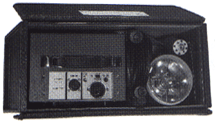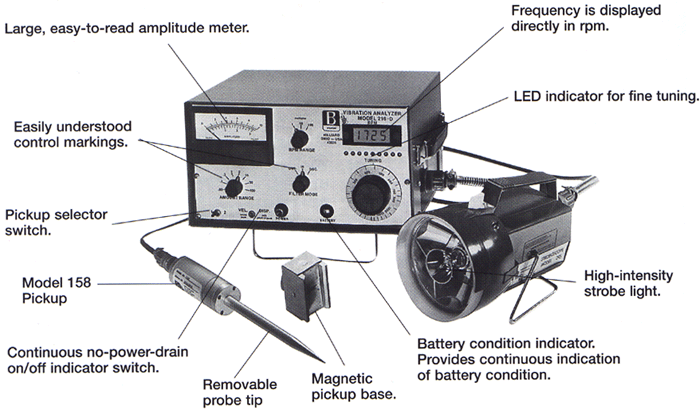 | |
FEATURES
● Machinery vibration analysis and dynamic
balancing, single and two plane
● On-the-spot trouble-shooting of vibration problems
● Large, easy to read meters
● Rugged, solid state construction
● Dual function, high intensity strobe
● Connects to X-Y recorders for graphing
APPLICATIONS
● Balancing - portable and shop
● Fans, motors, pumps, compressors, spindles
● Rotating machinery vibration analysis and balancing
● Predictive maintenance programs
DEscRIPTION
Balmac's Model 216-D Vibration Analyzer/Balancer is designed to check vibration of rotating machinery as well as balance machines on a day-to-day basis. It is an essential instrument for start up and basic, low-cost predictive maintenance programs.
The Model 216-D is especially useful for training personnel in vibration analysis. It features a large, easy-to-read analog amplitude meter, a digital frequency meter and a dual function, high intensity strobe light for balancing that also provides concen-trated light on the workpiece.
Instrumentation is enclosed in a dust- and rain-tight enclosure so the instrument can be used in shop or on field-service applications.
Instruction materials are easy to understand, and minimal training is required for personnel to conduct accurate and rapid analysis and balancing on rotating machinery. |
|
The 216-D
Analyzer/Balancer,probe, strobe and cables are fitted into a heavy-duty, aviation- style case. The unit packs in such a way to permit recharging of battery without removing the instrument from the case.
The case fits easily under airline seats. |
|
 |
BENEFITS OF VIBRATION ANALYSIS
Vibration analysis is an effective maintenance tool that can help rotating equipment manufacturers, service contracotrs and maintenance departments save repair costs and increase profitability.
Studies show most rotating machinery failures are preceded by a rise in vibration levels. Excessive vibration results in bad bearings, cracks in pipes and foundations, broken mounting bolts, misalignment and unbalance. Even more serious, and entire HVAC system, production line, or pumping operation could be shut down due to an individual piece of machinery failing.
Periodically measuring and recording vibration data in rotating machinery reveals trends and increased vibraiton levels. Analyzing this data assists operators to schedule maintenance. Minor, less costly problems are corrected before they become expensive failures. |
 |
| SPECIFICATIONS |
| RANGES |
English: 0.03, 0.1, 0.3, 1, 3, 10, 30, 100 Mils (peak to peak) & in/sec (peak)-full scale
Metric: 1, 3, 10, 30, 100, 300, 1000, 3000 μm (peak to peak) & mm/sec (peak)-full scale (optional mertic units) |
| MINMUM READING |
|
| SENSITIVITY |
Displacement - 0.000001 in. (0.2μm)
Velocity - .001 in/sec (0.02 mm/sec) |
| ACCURACY |
5% |
| FREQUENCY METER |
0 TO 200,000 rpm |
| TURNABLE FILTER |
165 to 200,000 rpm |
| ACCESSORIES |
Model 158 Pickup with removable probe, magnetic pickup base
Model 295 strobe light, carrying case, cables and rechargeable battery |
| POWER |
117/220 V 50/60 Hz or internal battery (30 hrs use per charge) |
| WEIGHT |
Instrument with battery: 11.6 lbs (5.26 kg)
Complete system in case: 25 lbs (11.3 kg) |
| SIZE |
Instrument: 11 3/4" × 6 3/4" × 9 1/4" (29.8 × 17.1 × 23.5 cm)
Case: 8" × 13" × 18" (20.3 × 33 × 45.7 cm) |
| INPUTS |
Two (for Model 158 pickup). (Unit may be calibrated for other pickups) |
| OUTPUT |
1. Signal for oscilloscope analysis (as vibration signal)
2. (Extra cost option) X-Y recorder (dc signals for amplitude and frequency) for vibration profiles |
| OPTIONAL EQUIPMENT |
Extra vibration pickup; X-Y recorder; extra magnetic base pickup; vice grip pickup base |
|
| VIBRATION ANALYZERS (AC & Battery Powered) (Portable Balancer) |
| MODEL 216-D VIBRATION ANALYZER / BALANCER KIT-1 |
10,060,000원 |
| |
Consisits of: |
216-D Analzer / Balancer (with Rechargeable Battery) |
|
| |
|
158 Vibration Pickup |
|
| |
|
041-15 Pickup Cable (15') |
|
| |
|
055 Magnetic Pickup Base |
|
| |
|
051 Probe Tip (7") |
|
| |
|
295 Strobe Light |
|
| |
|
044-15 Strobe Cable (15') |
|
| |
|
021-000 AC Power Cord |
|
| |
|
037 Carrying Case |
|
| |
|
Pad Polar Graph Paper |
|
| |
|
Manual and Calibration Certificate |
|
| MODEL 216-D VIBRATION ANALYZER / BALANCER KIT-2 (Kit-2 has 2-Pickup Sets) |
10,760,000원 |
| VIBRATION ANALYZER & VIBRATION METER ACCESSORIES |
| 051 |
PROBE (7") (for 158 and 160 Pickups) |
60,000원 |
| 055 |
MAGNETIC PICKUP BASE (for 158 and 160 Pickups) |
190,000원 |
| 056 |
VISE-GRIP PICKUP BASE (for 158 and 160 Pickups) |
190,000원 |
| 057 |
FISH-TAIL SHAFT STICK BASE (for 158 and 160 Pickups) |
190,000원 |
| 158 |
VIBRATION PICKUP (Velocity Type) |
780,000원 |
| 160 |
VIBRATION PICKUP (Integrated Electronic Velocity used for Low-Frequency) |
780,000원 |
| 041-15 |
VIBRATION PICKUP CABLE (15') (for 158 Pickup) |
190,000원 |
| 041-25 |
VIBRATION PICKUP CABLE (25') (for 158 Pickup) |
220,000원 |
| 041-xx |
PICKUP CABLE (for 158 Pickup) xx = Length @ $1.30 per foot |
150,000원 |
| 048-15 |
VIBRATION PICKUP CABLE (15') (for 160 Pickup) |
190,000원 |
| 048-25 |
VIBRATION PICKUP CABLE (25') (for 160 Pickup) |
220,000원 |
| 048-xx |
PICKUP CABLE (for 160 Pickup) xx = Length @ $1.30 per foot |
150,000원 |
| 045-15 |
STROBE CABLE (15') (for 297 Strobe for the Model 214) |
190,000원 |
| 044-15 |
STROBE CABLE (15') (for 295 Strobe for the Model 216-D) |
190,000원 |
| 036 |
SHIPPING CASE (for Model 216-D) |
780,000원 |
| 037 |
CARRYING CASE (for Model 214 and 216-D) |
220,000원 |
| 21-000 |
AC POWER LINE CORD (for Model 216-D) |
70,000원 |
| 20-600 |
DC POWER CORD (for Model 216-D) |
40,000원 |
| 295 |
STROBE LIGHT (5-pin connector) (for the Model 216-D) |
1,930,000원 |
| 297 |
STROBE LIGHT (6-pin connector) (for the Model 214) |
1,930,000원 |
| 8106 |
VIBRATION RECORD SHEETS |
10,000원 |
| 8107 |
VIBRATION MAINTENANCE RECORD SHEETS |
10,000원 |
| GRAPH |
POLAR-GRAPH PAPER 25-SHEETS (Balancing Record Work Sheet) |
7,000원 |
| METRIC |
METRIC UNIT CALIBRATION & NOMENCLATURE |
031-777-1588 |
| BAL-CP |
CALCULATOR FOR BALANCING (HP-48) |
670,000원 | | |
|
|
 | |
 |
|
 |
|
이 상품에 대한 사용후기가 아직 없습니다.
사용후기를 작성해 주시면 다른 분들께 많은 도움이 됩니다. |
|
 |
|
 |
|
|
 | |
 |
|
 |
|
이 상품에 대한 질문이 아직 없습니다.
궁금하신 사항은 이곳에 질문하여 주십시오. |
|
 |
|
 |
|
|
|




















